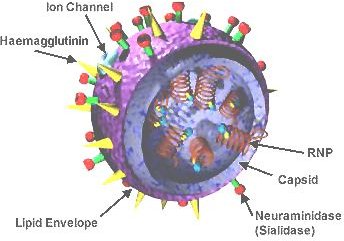Flu Virus Genetics: The Genome of Influenza
Anatomy of a Flu Virus
Influenza belongs to a family of viruses called the Orthomyxoviridae, which contains five genera or “kinds”: Influenzavirus A, Influenzavirus B, Influenzavirus C, Thogotovirus, and Isavirus. (Read more on influenza virus classification.) These viruses all consist of a protein and lipid coat about 80-120 nm across, encapsulating a core of genetic material about 9 nm in diameter. The shape can be either roughly spherical or long and filamentous, up to 2000 nm long. The coat is studded with lumps of two proteins, haemagglutinin (H) and neuraminidase (N), which make it possible for the virus particle (virion) to enter the host cell.
The Influenza Virus Genome
The material inside the core consists of 8 unique segments (7 in Influenza C) of negative-sense RNA, wrapped around nucleoproteins in a helix. This combination of RNA and protein is called ribonucleoprotein (RNP). “Negative-sense” means that the RNA strand is complementary to the mRNA from which proteins are made. The genome has a total of 13,588 bases. Influenza viruses replicate by using the host cell to replicate their RNA without ever using a DNA intermediary. This distinguishes them from retroviruses; instead, they are called RNA viruses or riboviruses.
Once inside the cell, the virus replicates its genome to positive-sense mRNA, which is used to make more virus proteins, and positive-sense cRNA, which serves as a template for replicating the genome. The cRNA is then replicated again to produce complementary negative-sense RNA strands that will become the genome of the daughter viruses. So each replication cycle requires two transcriptions. (The RNA-RNA replications are similar to how DNA is converted into RNA).
Riboviruses: The Fastest Mutation
RNA is a less stable molecule than DNA, so it is subject to more mutations. Riboviruses like influenza use RNA exclusively, and as a result they mutate faster than any other kind of virus.
Virus mutation rates are measured as the mutations per genome per replication (μg) — that is, the average number of mutations that will occur each time a single virus particle (virion) copies its genome. DNA viruses — those that use only DNA at all stages of their replication cycle — have the lowest mutation rate, μg = 0.0034. Retroviruses, which use both DNA and RNA in their replication cycle, have a much higher rate of about 0.2.
Influenza and other riboviruses have an incredible μg of about 0.67 to 0.76. Since each complete virus replication cycle requires two transcriptions, that means each daughter virus has an average of 1.34 to 1.52 mutations! The superfast mutation rate of influenza is what fuels its ability to evolve and adapt, overcoming the immune system’s method of recognizing old pathogens.
References
- John W. Drake and John J. Holland. “Mutation rates among RNA viruses.” Proceedings of the National Academy of Sciences November 23, 1999 96(24):13910-3.
- “Myxoviruses.” MicrobiologyBytes.com.
Image credit: National Institutes of Health.
